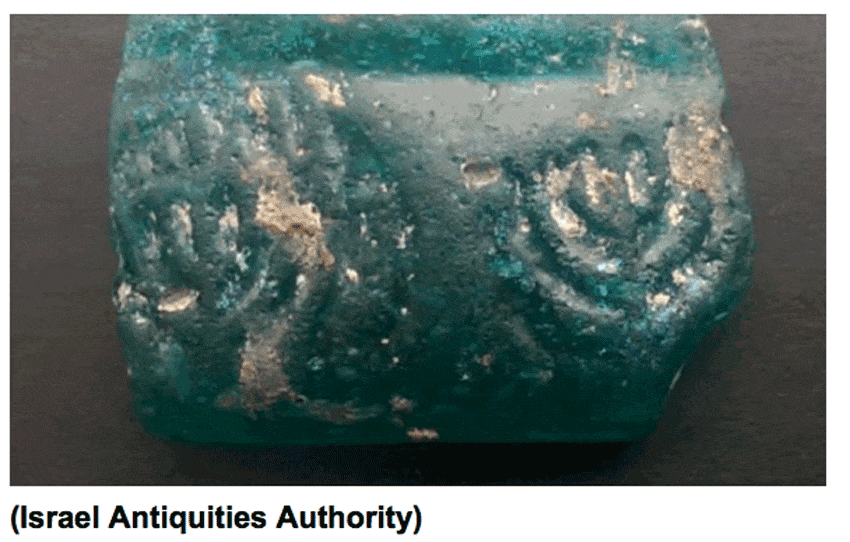A fragment from a glass bracelet inscribed with a seven- branched menorah from the Second Temple was discovered during Hanukka at an excavation in the Mount Carmel National Park.
“Stamped impressions of two menorahs survived on the small fragment that was found—one a plain seven-branched menorah, of which only the surface of the menorah is visible, and the other one consisting of a seven-branched menorah with flames depicted above its branches,” according to excavation co-directors Limor Talmi and Dan Kirzne of the Israel Antiquities Authority. They told The Jerusalem Post that glass bracelets are usually found in the region as funerary offerings. This bracelet may indicate that Jews lived in the settlement, or that the bracelet had been made in a local workshop for export.
According to a statement from the Antiquities Authority, excavations took place there in recent weeks prior to the construction of a water reservoir for the city of Yokne’am, at the initiative of national water company Mekorot.
The dig exposed an industrial region and refuse pits that were part of a large settlement in the late Roman and early Byzantine periods, during the end of the fourth century CE and beginning of the fifth, the authority said.
The excavation’s co-directors, Limor Talmi and Dan Kirzne, said in a joint statement that they had made the findings at the end of the dig last Thursday.
“While examining the contents of one of the boxes, which contained hundreds of glass fragments that had been discarded in the refuse pit, we found to our surprise a small fragment of a bracelet,” they said. “Naturally it was extremely dirty, but still, you could see it was decorated. After cleaning, we were excited to discover that the bracelet, which is made of turquoise-colored glass, is decorated with symbols of the seven-branched menorah – the same menorah which, according to tradition, was kept alight in the Temple for eight days by means of a single cruse of oil.”
The researchers added that they believed the bracelet had been embossed with the decoration while the glass was still hot.
“Stamped impressions of two menorot survived on the small fragment that was found – one a plain seven-branched menorah, of which only the surface of the menorah is visible, and the other one consisting of a seven-branched menorah with flames depicted above its branches,” they said.
According to Yael Gorin-Rosen, head of the Antiquities Authority’s Ancient Glass Department, glass bracelets and pendants from these periods decorated with symbols of a menorah, lion or different images of gods and animals are well known in Israel, Lebanon and Syria.
“So far, three fragments of bracelets with menorah decorations have been discovered in archeological excavations in the country: in an excavation at Bab el-Hawa in the northern Golan Heights, at the Banias, and another bracelet that was discovered years ago in the excavations at Shikmona, Haifa,” she said. “The Shikmona bracelet is also adorned with an image of a menorah that has flames above it.”
Rosen-Gorin explained that archeologists usually found this kind of jewelry in the context of funerary offerings.
“It is unusual to find such objects in settlement strata, and even rarer to discover them in an ancient refuse pit,” she added.
The Antiquities Authority researchers said that while the findings may provide proof that Jews lived in the ancient settlement, it was also possible that Samaritan, pagan or Christian populations had resided there.
Another hypothesis, they said, was that the bracelet came from a workshop operating in the area and had been intended for other markets.
This possibility is based on other glass debris that researchers found in the refuse pit, among them beads and bracelets, the archeologists said.
“Glass jewelry was used extensively in the late Roman period, and we can reasonably assume that those items that were specially decorated were more expensive than the plain, unornamented ones,” they said. “The refuse that was discovered in the pit included numerous glass vessels and fragments of glass window panes, as well as a selection of jewelry, indicative of a population that lived a life of comfort and affluence.”
Therefore, they theorized, it is conceivable that the large industrial area there supported the residents of the nearby settlement.







Leave A Comment